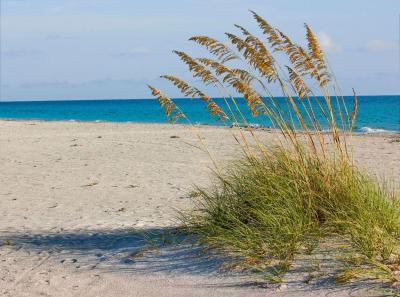
Question: What are sea oats?
Answer: Sea oats are in the grass family and native to the NC coast. Sea oats get their name from the flower stalks that develop in summer and look like ‘cereal grain oat seed heads’’ as illustrated in the picture above.
Question: Why are sea oats the plant of choice for restoring unvegetated dunes?
Answer: Sea oats are native with a root system that can survive the winters here on the coast. Another key feature is that as a grass growing low to the ground, sea oat stems trap blowing sand (mostly only 6 inches high above beach level) and holds it just like snow fencing along mountain roads keeps the snow from drifting across the road. As the sand piles up year after year, the sea oats stems grow longer and thus a repetitive cycle is created year after year for natural dune building.
Question: Why is it important to vegetated dunes?
Answer: Coastal Area Management Act (CAMA) rules in NC dictate that pilings (posts) for beach access cross-overs cannot be placed in unvegetated dunes. While this is an inconvenience for property owners with private cross-overs and town CAMA public accesses, stabilizing the dune as described above is the ultimate goal.
Question: Who is harvesting the sea oats?
Answer: Coastal Transplants conducts the harvesting in Caswell Beach. Coastal Transplants offers specific environmental and horticultural expertise with practical, first-hand knowledge of all aspects of Coastal Revegetation projects. They have extensive agricultural and horticultural experience that focuses on restoring the coastal ecology of our island community. Coastal Transplants is a leading provider of dune construction, maintenance, & repair. Dunes, native sea oats, and fencing come together to provide the most stable protection against storms and erosion. They use a very deliberate method to ensure that we receive the heartiest plants with the fastest growth rates.
Question: What do you do with the sea oats you harvest? Are they replanted in our dunes, or do they go to another beach?
Answer: The seeds are used for Caswell and local beaches as other neighbor beach seed has been used on Caswell Beach. The last harvest at Caswell Beach was in 2023. The town projects and residential jobs we have done in Caswell Beach have depleted the Caswell Beach seed.
Question: If they are replanted, when is this scheduled to happen?
Answer: Sea oats season is from mid-April to late September for transplanting.
Question: Most of the dunes in Caswell Beach are owned by individual homeowners, though CAMA prohibits them from doing whatever they want in the dunes because it is protected. Since they do own their individual parcels and those parcels include the dune, North Carolina General Statute §14-129.2 states that it is unlawful to dig up, pull up, or take from the land of another or from any public domain the whole or any part of any Sea Oats without the consent of the owner of that land. Is there another section of the Statutes that overrides §14-129.2?
Answer: During most renourishments, easements are given and in most cases in NC Federal, State and local governments can access these areas for maintenance, improvement and restoration. Most municipalities that have been renourished in the past allow the harvest of seed or plant material in renourished areas and within the easement previously provided.
Question: How does harvesting sea oats benefit the Town of Caswell Beach and its residents?
Answer: Sea oat seed that would naturally fall off the plant during the fall results in only 1 out of 100,000 that grow to a new sea oat. In managed conditions, such as harvesting and replanting, 1 out of 10 will grow to a new sea oat. For an average lot in Caswell Beach, a dune needs about 2,000 sea oats to be considered established (each lot may vary). If a storm was to severely damage the dune, it would take many years of growth before the required amount of sea oats were present for the dune to be considered established vegetation. If using local seed, the transplant survival rate is increased with the plant having a 90% survival rate when transplanted from local seed grown in a greenhouse environment.
